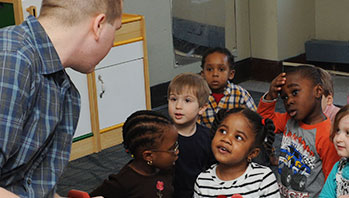- crayons (shades of yellow)
- paint squares (one light yellow; one dark yellow)
- pictures of yellow objects (different shades; recognizable objects)
- darkest
- lightest
- shade
- yellow
MA Standards:
Speaking and Listening/SL.PK.MA.1: Participate in collaborative conversations with diverse partners during daily routines and play.
Language/L.PK.MA.1: Demonstrate use of oral language in informal everyday activities.
Language/L.PK.MA.6: Use words and phrases acquired through conversations, listening to books read aloud, activities, and play.
Language/L.PK.MA.5.a: Demonstrate understanding of concepts by sorting common objects into categories (e.g., sort objects by color, shape, or texture).
MA Draft STE Standards
Physical Sciences: Matter and Its Interactions: Structure and Properties of Matter/PS1.A: Describe, compare, sort and classify objects based on observable physical characteristics, uses, and whether it is manufactured as part of their classroom play and investigations of the natural and human-made world.
Head Start Outcomes:
Language Development/Receptive Language: Attends to language during conversations, songs, stories, or other learning experiences.
Language Development/Expressive Language: Uses language to express ideas and needs.
Language Development/Expressive Language: Uses increasingly complex and varied vocabulary.
PreK Learning Guidelines:
English Language Arts/Language 2: Participate actively in discussions, listen to the ideas of others, and ask and answer relevant questions.
English Language Arts/Language 3: Communicate personal experiences or interests.
Talk Together: Color Words

© Commonwealth of Massachusetts, Department of Early Education and Care (Jennifer Waddell photographer). All rights reserved.
STEM Key Concepts: There are many different colors; A color can have many different colors (from very light to very dark)
ELA Focus Skills: Color Recognition, Follow Directions, Speaking and Listening, Vocabulary
Educator Prep: Gather pictures of yellow objects that correspond to the names on the yellow crayons (sunglow, dandelion, banana, etc.)
Continue the discussion about the many different shades of color in our environment. Have children name some things in nature that are yellow. Name some foods that are yellow.
Then spread yellow crayons on a table and ask children to describe the crayons. (different shades of yellow)
Place the paint squares at opposite ends of the table and encourage children to help you sort and line up the crayons in order, from lightest to darkest. Then read the name on each crayon. Ask questions such as,
- Why do you think all the names on these yellow crayons are different?
- Why do you think they have names of real things in the world, such as lemon or dandelion or wheat?
Hold up the corresponding pictures of yellow objects as prompts. Talk about how the different names help people think of a popular food, object, or something in their environment.
- Hold up yellow crayon and a yellow image. Say, Imagine you were asked to name this shade of yellow. What would you call it? Prompt children to respond in full sentences. (I would call it sunny yellow; I would call it bright-star yellow.)
- Continue with other colors.
Adaptation: If younger children have trouble concentrating, split the activity into two separate activites: one day have them sort the crayons and the next day do the crayon naming activity at another time.
